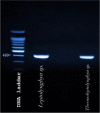Laser Treatment Increases the Antimicrobial Efficacy of Cyanobacterial Extracts against Staphylococcusaureus (SA) and Methicillin-resistantStaphylococcus aureus (MRSA)
- PMID: 36293886
- PMCID: PMC9603216
- DOI: 10.3390/ijerph192013305
Laser Treatment Increases the Antimicrobial Efficacy of Cyanobacterial Extracts against Staphylococcusaureus (SA) and Methicillin-resistantStaphylococcus aureus (MRSA)
Abstract
Staphylococcus aureus (SA) and Methicillin-resistant Staphylococcus aureus (MRSA) are multidrug-resistant bacterial pathogens. A novel approach needs to be followed to combat these pathogens in an ecofriendly manner. Cyanobacterial extracts were previously proven to be affective as antimicrobial agents. To capitalize on this, laser treatments were used to increase their antimicrobial efficacy. Two cyanobacterial strains isolated from Al-Ahsa were identified using molecular methods. Their aqueous extracts were used in the antimicrobial bioassay for these two bacterial pathogens. The first group of aqueous extracts were exposed directly to laser treatment and used in antibacterial bioassay. In parallel, the cyanobacterial biomass of the two isolates was exposed to the laser, then aqueous extracts were prepared. The third group of extracts were not exposed to the laser and were used as a control. Time and distance were the factors tested as they affected the dose of the laser, both individually and in combination. In addition, accessory pigment estimation in extracts before and after laser exposure of extracts was also determined. The two cyanobacterial strains were identified as Thermoleptolyngbya sp. and Leptolyngbya sp. and the molecular analysis also confirmed the identity of pathogenic bacteria. The untreated cyanobacterial aqueous extracts had little effect against the two bacterial strains. In contrast, the extract directly exposed to the laser was significantly more effective, with an inhibition zone of 22.0 mm in the case of a time of 32 min and distance of 10 cm against S. aureus. Accessory pigment composition increased in extracts directly exposed to the laser. This is the first case report on the effect of lasers on enhancing the antimicrobial profile of cyanobacterial extracts against SA and MRSA bacterial pathogens, as well as enhancing accessory pigment content. The laser dose that was most effective was that of 32 min time and 10 cm distance of Thermoleptolyngbya sp. extract directly exposed to the laser, which highlights the importance of time for increasing the laser dose and consequently increasing its antimicrobial impact.
Keywords: Leptolyngbya sp.; Methicillin-resistant Staphylococcus aureus (MRSA); Staphylococcus aureus (SA); Thermoleptolyngbya sp.; antimicrobial bioassay; aqueous extracts; laser; phycocyanin.
Conflict of interest statement
The authors declare no conflict of interest.
Figures




Similar articles
-
Investigation of Morchella esculenta and Morchella conica for their antibacterial potential against methicillin-susceptible Staphylococcus aureus, methicillin-resistant Staphylococcus aureus and Streptococcus pyogenes.Arch Microbiol. 2022 Jun 14;204(7):391. doi: 10.1007/s00203-022-03003-8. Arch Microbiol. 2022. PMID: 35699800
-
Synergistic antibacterial effects of herbal extracts and antibiotics on methicillin-resistant Staphylococcus aureus: A computational and experimental study.Exp Biol Med (Maywood). 2017 Apr;242(7):731-743. doi: 10.1177/1535370216689828. Epub 2017 Jan 1. Exp Biol Med (Maywood). 2017. PMID: 28118725 Free PMC article.
-
Antibacterial and antibiofilm activities of Mayan medicinal plants against Methicillin-susceptible and -resistant strains of Staphylococcus aureus.J Ethnopharmacol. 2021 Oct 28;279:114369. doi: 10.1016/j.jep.2021.114369. Epub 2021 Jun 26. J Ethnopharmacol. 2021. PMID: 34186100
-
Methicillin-resistant Staphylococcus aureus: a controversial food-borne pathogen.Lett Appl Microbiol. 2017 Jun;64(6):409-418. doi: 10.1111/lam.12735. Epub 2017 May 3. Lett Appl Microbiol. 2017. PMID: 28304109 Review.
-
Correlation Between Biofilm Formation and Antibiotic Resistance in MRSA and MSSA Isolated from Clinical Samples in Iran: A Systematic Review and Meta-Analysis.Microb Drug Resist. 2020 Sep;26(9):1071-1080. doi: 10.1089/mdr.2020.0001. Epub 2020 Mar 10. Microb Drug Resist. 2020. PMID: 32159447
Cited by
-
Laser enhanced photothermal effect of silver nanoparticles synthesized by chemical and green method on Gram-positive and Gram-negative bacteria.BMC Chem. 2024 Sep 3;18(1):163. doi: 10.1186/s13065-024-01263-7. BMC Chem. 2024. PMID: 39227976 Free PMC article.
-
Study of the Antimicrobial Potential of the Arthrospira platensis, Planktothrix agardhii, Leptolyngbya cf. ectocarpi, Roholtiella mixta nov., Tetraselmis viridis, and Nanofrustulum shiloi against Gram-Positive, Gram-Negative Bacteria, and Mycobacteria.Mar Drugs. 2023 Sep 14;21(9):492. doi: 10.3390/md21090492. Mar Drugs. 2023. PMID: 37755105 Free PMC article.
References
-
- Martínez-Francés E., Escudero-Oñate C. Cyanobacteria and microalgae in the production of valuable bioactive compounds. Microalgal Biotechnol. 2018;6:104–128.
-
- Mandal S., Rath J. Extremophilic Cyanobacteria for Novel Drug Development. Springer; Berlin/Heidelberg, Germany: 2015. Secondary metabolites of Cyanobacteria and drug development; pp. 23–43.
Publication types
MeSH terms
Substances
LinkOut - more resources
Full Text Sources
Medical
Molecular Biology Databases

